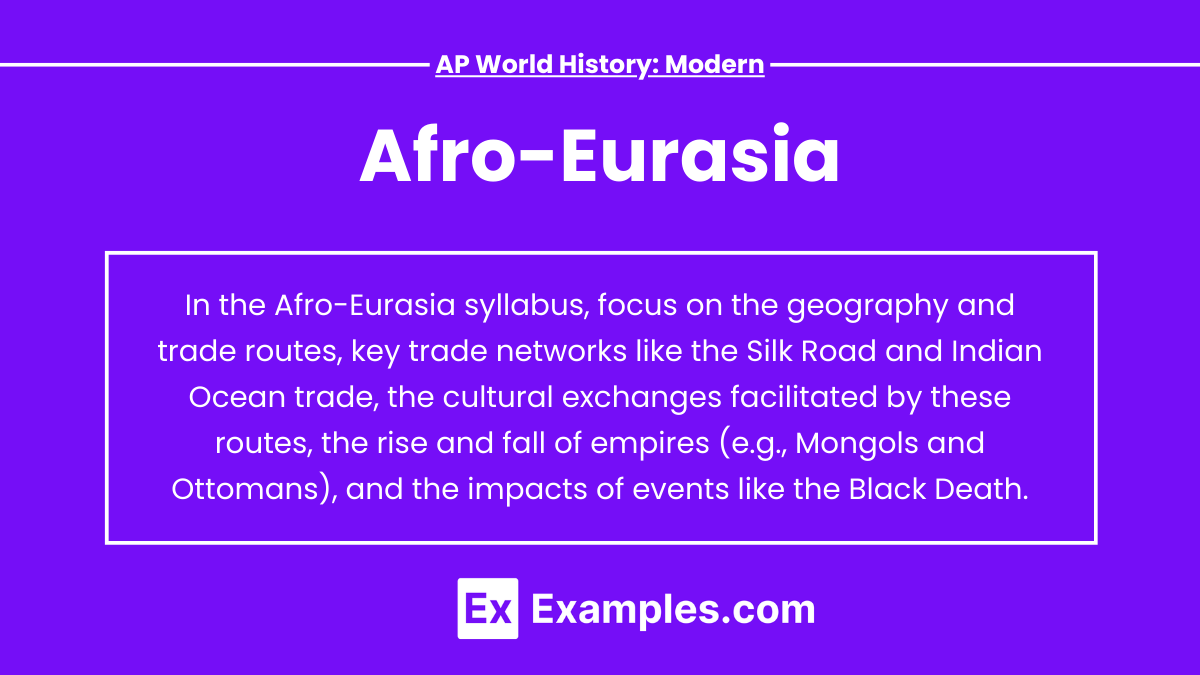Afro-Eurasia, encompassing Africa, Europe, and Asia, represents one of the most significant landmasses in human history. This interconnected region has been a hub of trade, cultural exchange, and political power for centuries. The Silk Road and Indian Ocean trade routes facilitated the movement of goods, ideas, and technologies, shaping civilizations across continents. Major empires, including the Mongols and Ottomans, emerged within Afro-Eurasia, influencing global dynamics and fostering rich cultural interactions that continue to resonate today.
Learning Objectives
When studying “Afro-Eurasia” for AP World History: Modern, focus on key learning objectives. Understand the geographical context by identifying major regions and trade routes and how they influenced history. Analyze trade networks like the Silk Road and Indian Ocean trade, emphasizing the goods exchanged and cultural impacts. Evaluate cultural exchanges, including the spread of religions and technologies. Explore the role of significant empires, such as the Mongol and Ottoman Empires, and their governance. Discuss the effects of the Black Death on demographics and society. Finally, connect historical events to contemporary global issues, such as trade and cultural identities, to grasp Afro-Eurasia’s lasting significance.
Afro-Eurasia is the vast landmass that includes Africa, Europe, and Asia. This region has historically been a center of civilization, trade, and cultural exchange.
1. Geographical Significance
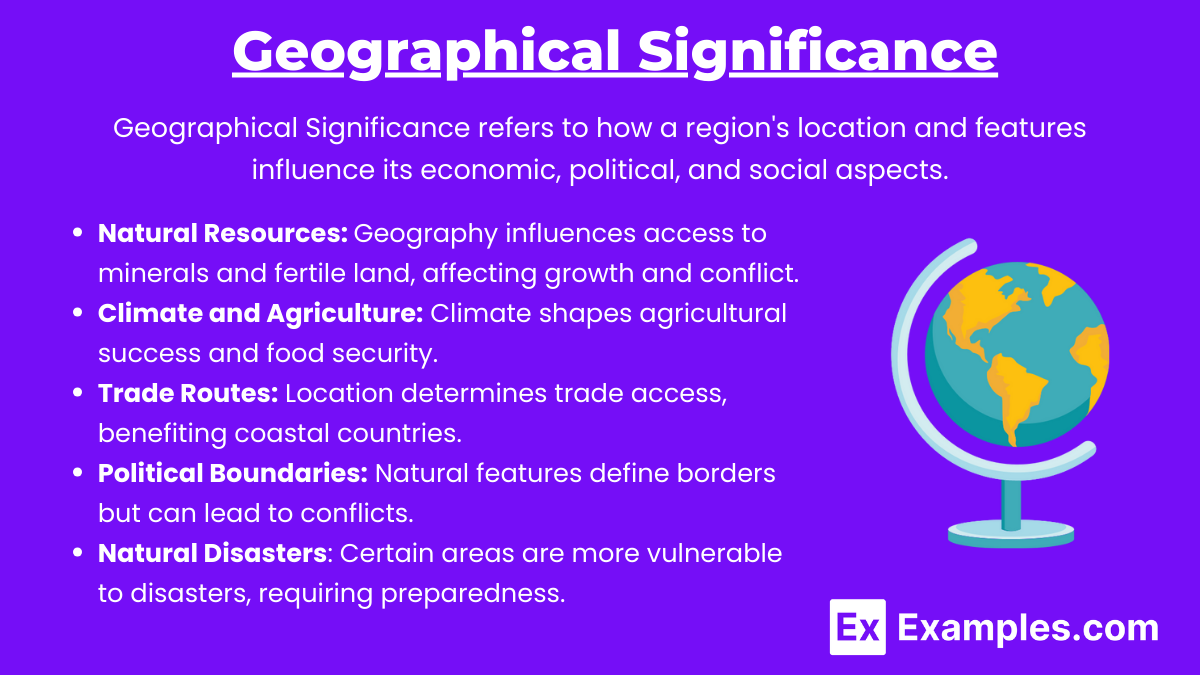
Geographical Significance refers to the importance of a region’s location, natural resources, climate, and physical features in shaping its economic, political, and social dynamics.
- Natural Resources: Geographical features influence the availability of natural resources such as minerals, oil, and fertile land. Regions rich in resources often experience economic growth but may also face challenges related to resource management and conflict.
- Climate and Agriculture: The climate of a region affects agricultural practices and food security. Areas with favorable climates can support diverse crops, while others may struggle with drought or extreme weather, impacting livelihoods and economies.
- Trade Routes: Geographical location determines trade routes and access to markets. Countries situated near coastlines or major waterways can engage in international trade more easily, enhancing economic opportunities.
- Political Boundaries: Geographical features, such as mountains and rivers, often define political boundaries. However, these natural barriers can also lead to conflicts, particularly in regions where artificial borders do not reflect ethnic or cultural divisions.
- Vulnerability to Natural Disasters: Certain geographical areas are more prone to natural disasters, such as earthquakes, floods, or hurricanes. This vulnerability impacts development and requires effective disaster management and preparedness strategies.
2. Cultural and Economic Exchanges
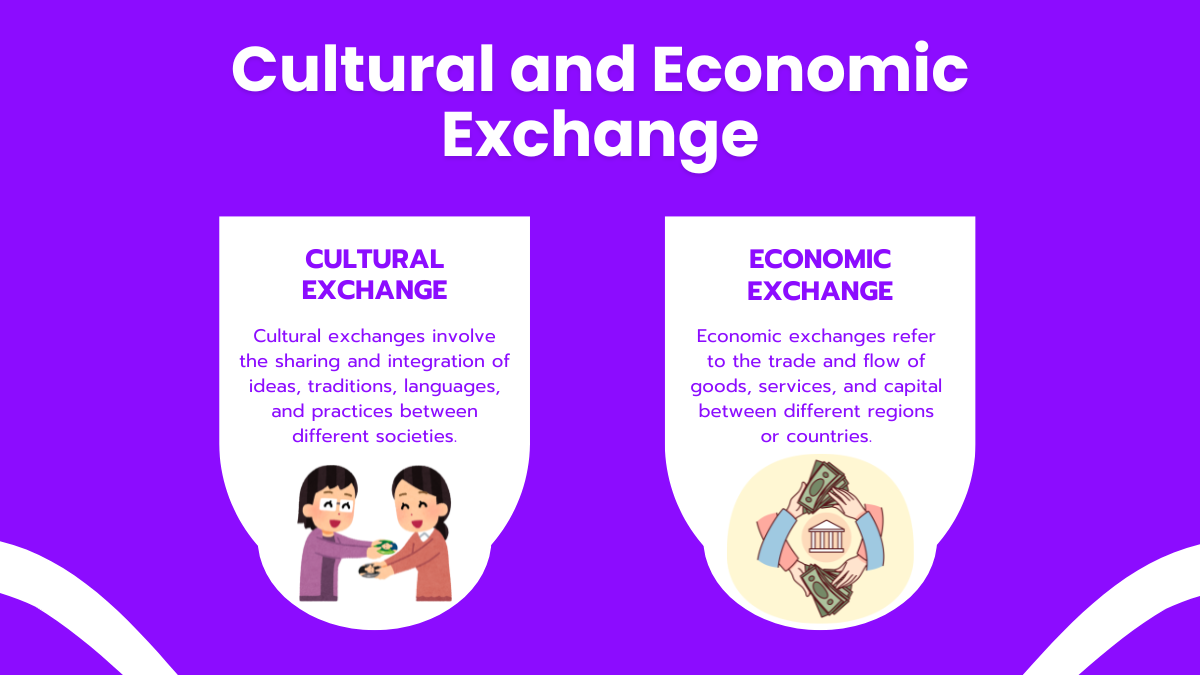
Cultural Exchanges
Cultural exchanges involve the sharing and integration of ideas, traditions, languages, and practices between different societies. This can occur through trade, migration, diplomacy, and communication. Key aspects include:
- Art and Music: Cultural exchanges enrich art forms and musical styles, leading to hybrid genres and new artistic expressions.
- Language: Interaction between cultures often results in language borrowing and the spread of dialects, enhancing communication and understanding.
- Traditions and Beliefs: The sharing of customs, rituals, and beliefs fosters mutual respect and appreciation, contributing to cultural diversity.
- Education and Knowledge: Academic collaboration and exchange programs allow for the sharing of knowledge and educational practices, enhancing learning experiences.
Economic Exchanges
Economic exchanges refer to the trade and flow of goods, services, and capital between different regions or countries. These exchanges are essential for economic development and can include:
- Trade Agreements: Bilateral and multilateral agreements facilitate trade by reducing tariffs and barriers, promoting economic growth.
- Investment: Foreign direct investment (FDI) brings capital into a region, fostering job creation and infrastructure development.
- Market Access: Countries gain access to larger markets through economic exchanges, allowing businesses to expand and increase competitiveness.
- Technology Transfer: Collaboration between nations can lead to the sharing of technology and innovation, enhancing productivity and economic efficiency.
3. Empires and Political Structures
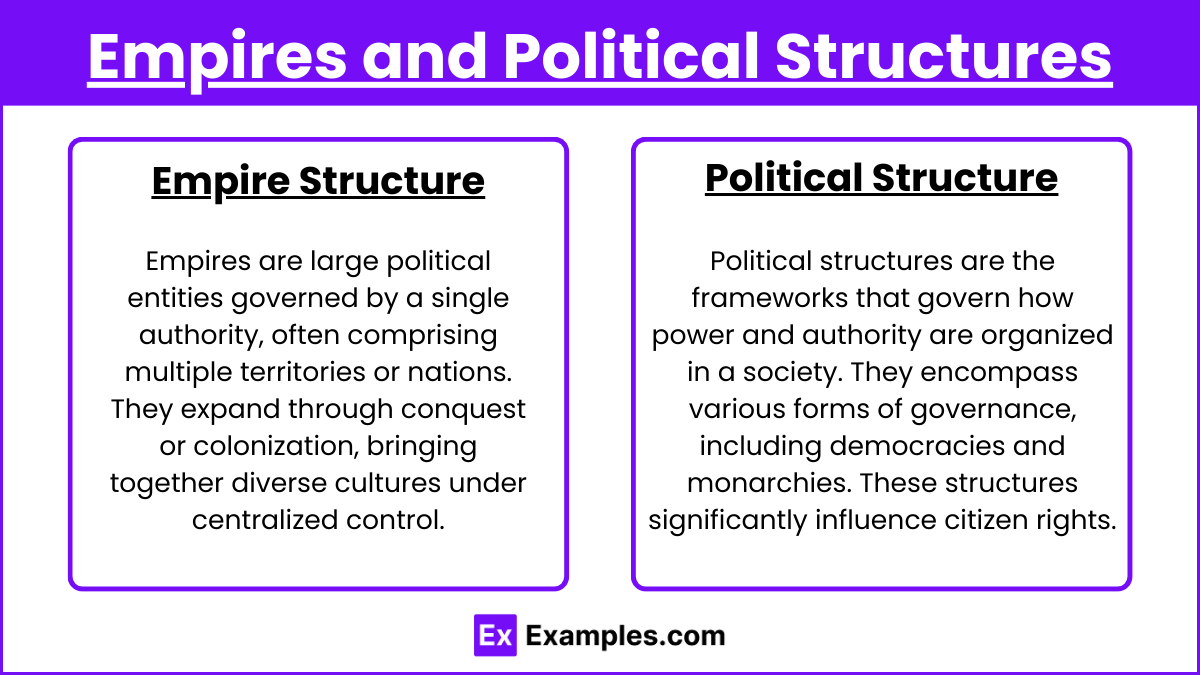
Empire Structure
Empires are extensive groups of states or countries under a single supreme authority, often led by an emperor or empress. They have played a significant role in shaping history through expansion, cultural exchange, and political dominance. Key aspects include:
- Expansion: Empires often expand through conquest, colonization, or diplomacy, incorporating diverse territories and peoples.
- Cultural Exchange: Interaction between different cultures within an empire leads to the sharing of ideas, traditions, and technologies, enriching the empire’s cultural fabric.
- Administration: Empires typically develop complex administrative systems to govern vast territories, often employing local leaders to maintain control.
- Economic Control: Empires exploit resources from their territories, often leading to economic benefits for the central authority while creating dependencies among the conquered regions.
Political Structures
Political structures refer to the organized systems of governance and authority within a society. They define how power is distributed and exercised. Key aspects include:
- Types of Government: Political structures can vary from democracies and monarchies to authoritarian regimes, each influencing citizen participation and rights.
- Institutions: Governments establish institutions (e.g., legislatures, courts, and executive bodies) to implement laws, provide services, and maintain order.
- Political Ideologies: Different ideologies, such as liberalism, socialism, and conservatism, shape the principles and policies of a political structure, influencing societal values and governance.
- Decentralization vs. Centralization: Political structures may vary in how power is distributed, with some emphasizing local governance (decentralization) and others concentrating authority in a central government (centralization).
4. Technological and Scientific Developments
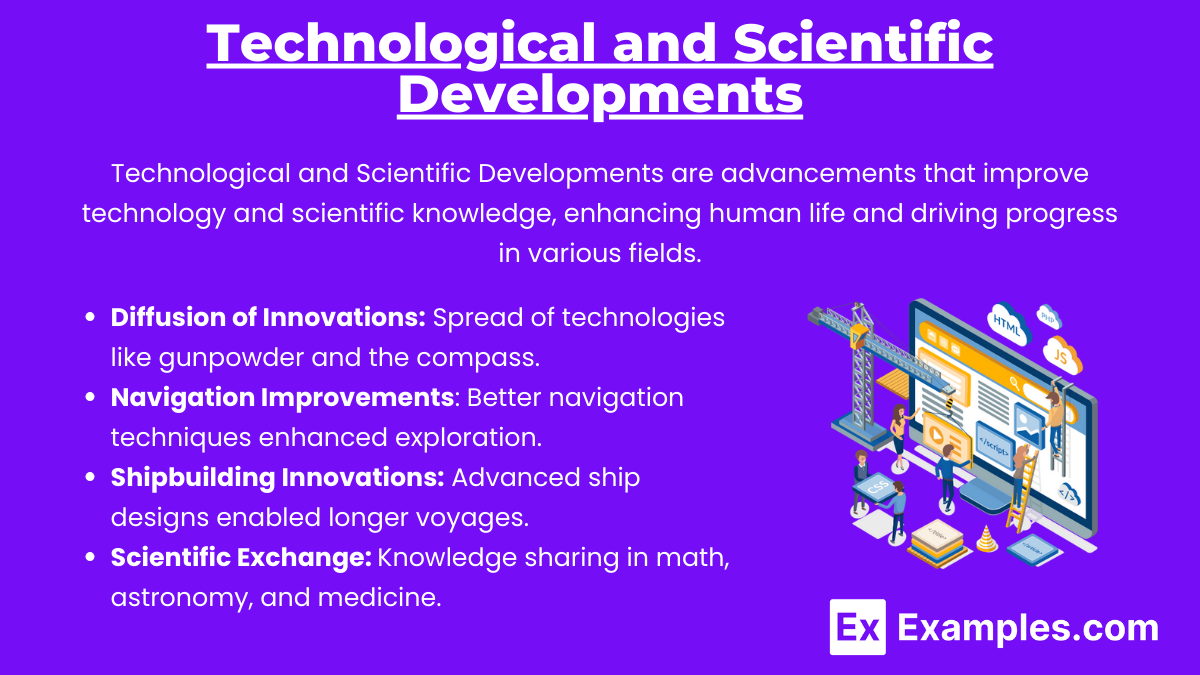
Technological and Scientific Developments refer to the advancements and innovations in technology and science that enhance human capabilities, improve quality of life, and drive economic growth. This includes discoveries, inventions, and improvements in various fields such as medicine, navigation, communication, and engineering.
- Diffusion of Innovations: Afro-Eurasia facilitated the spread of significant technologies like gunpowder, the compass, and papermaking, influencing military, navigation, and communication.
- Navigation Improvements: Advancements in navigation techniques, including the use of astrolabes and improved maps, enhanced maritime exploration and trade routes.
- Shipbuilding Innovations: Developments in ship design, such as the caravel, allowed for longer and more efficient voyages, enabling explorers to reach new lands.
- Scientific Exchange: Cross-cultural interactions led to the sharing of knowledge in fields like mathematics, astronomy, and medicine, enriching scientific understanding.
- Impact on Exploration: These technological advancements played a crucial role in the Age of Exploration, allowing European powers to establish global trade networks and colonies.
5. Impact of the Plague

The plague, particularly the Black Death in the 14th century, had profound effects on Europe and beyond. It caused an estimated 25-30 million deaths, reducing the population by about one-third and leading to significant labor shortages. This scarcity resulted in higher wages for workers and contributed to the decline of feudalism as economic power shifted from landowners to laborers. Socially, the loss of life prompted a more individualistic perspective on life and death, reflected in cultural shifts toward themes of mortality in art and literature. The outbreak also led to the development of public health measures, such as quarantine, which laid the groundwork for modern health systems. Additionally, it challenged the authority of the Church, spurring interest in religious reform. While trade routes were disrupted, the eventual economic recovery facilitated increased commerce and helped pave the way for the Renaissance. Overall, the impact of the plague was multifaceted, reshaping demographics, economies, societies, cultures, and health practices across Europe.
Examples
Example 1 : The Silk Road Trade Network
The Silk Road was one of the most significant overland trade routes that connected Afro-Eurasia, spanning from China to the Mediterranean. It facilitated the exchange of luxury goods such as silk, spices, and precious stones. Beyond trade, the Silk Road played a crucial role in cultural exchanges, spreading religions like Buddhism, and transmitting knowledge of art, technology, and science across Afro-Eurasia.
Example 2 : Indian Ocean Maritime Trade
The Indian Ocean trade network connected East Africa, the Arabian Peninsula, India, and Southeast Asia, making it a major maritime route in Afro-Eurasia. Goods like ivory, gold, and textiles were transported across this network, and cities such as Kilwa, Mombasa, and Calicut became vibrant trade hubs. Additionally, this route allowed for the spread of Islam, facilitating the fusion of cultures and the growth of cosmopolitan cities.
Example 3 : Mongol Empire’s Unification
In the 13th century, the Mongol Empire emerged as a dominant force that unified much of Afro-Eurasia. Under the rule of Genghis Khan and his successors, the Mongols created a vast empire that stretched from China to Eastern Europe. This unification led to increased security on trade routes like the Silk Road and fostered unprecedented levels of communication, trade, and cultural interaction between Europe and Asia.
Example 4 : Ottoman Empire’s Role in Afro-Eurasia
The Ottoman Empire, which controlled key regions in both Europe and Asia, became a pivotal player in Afro-Eurasian trade and politics. After capturing Constantinople in 1453, the Ottomans controlled major land and sea routes, connecting Europe and Asia. This control allowed them to dominate trade, especially in goods like silk, spices, and coffee, influencing the economies and cultures of Afro-Eurasia.
Example 5 : The Spread of the Black Death
The Black Death, a devastating plague that struck Afro-Eurasia in the mid-14th century, exemplifies the interconnectedness of the region. The plague spread through trade routes, including the Silk Road and maritime channels, killing millions of people across Europe, Asia, and North Africa. This pandemic led to significant social, economic, and political changes, as it severely disrupted societies in Afro-Eurasia.
Multiple Choice Questions
Question 1
What was one of the most significant impacts of the Silk Road on Afro-Eurasia?
a) The spread of Christianity across the region
b) The development of advanced maritime technology
c) The exchange of goods, cultures, and ideas across continents
d) The destruction of major cities due to Mongol invasions
Answer: c) The exchange of goods, cultures, and ideas across continents
Explanation:
The Silk Road was not just a trade route for luxury items like silk and spices; it also facilitated the exchange of cultural, religious, and intellectual ideas across Afro-Eurasia. It connected regions from China to the Mediterranean, allowing for the spread of Buddhism, art, and technologies like papermaking. This network fostered cultural diffusion, making it a key factor in Afro-Eurasia’s interconnected history.
Question 2
Which of the following empires played a key role in unifying much of Afro-Eurasia in the 13th century?
a) The Byzantine Empire
b) The Mongol Empire
c) The Ottoman Empire
d) The Gupta Empire
Answer: b) The Mongol Empire
Explanation:
The Mongol Empire, under Genghis Khan, unified vast portions of Afro-Eurasia, extending from China to Eastern Europe. This unification led to a period of increased safety on trade routes, particularly the Silk Road, and allowed for significant cultural and commercial exchanges between regions that had previously been more isolated.
Question 3
Why was the Indian Ocean trade network important for Afro-Eurasia?
a) It facilitated the spread of Christianity across the region
b) It connected key port cities in East Africa, the Middle East, India, and Southeast Asia
c) It allowed European powers to dominate trade with Asia
d) It primarily focused on land-based trade routes like the Silk Road
Answer: b) It connected key port cities in East Africa, the Middle East, India, and Southeast Asia
Explanation:
The Indian Ocean trade network was a vital maritime trade route that linked the eastern coasts of Africa, the Arabian Peninsula, India, and Southeast Asia. It allowed the exchange of goods such as gold, ivory, and spices. The network also facilitated cultural exchanges, such as the spread of Islam to Southeast Asia, making it a crucial part of Afro-Eurasian history.

